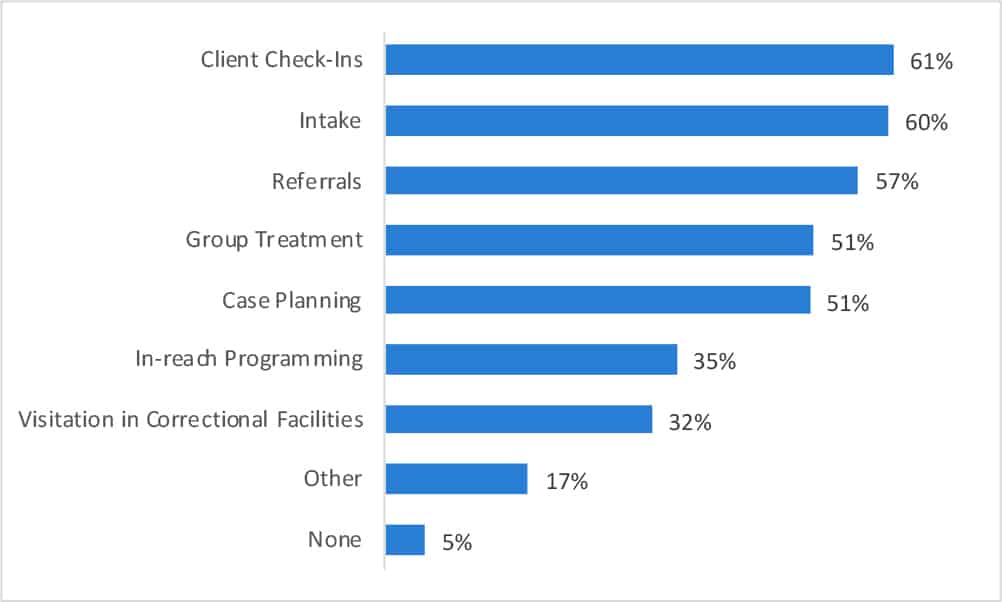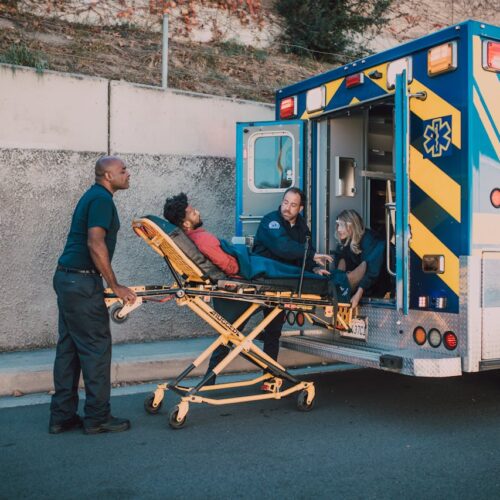
Reentry in the Wake of COVID-19: Service Providers Adapt but Need More Support to Address Community Needs
COVID-19 has impacted corrections and reentry in profound ways as agencies and organizations have suspended, pivoted, and adapted protocols and programming to maintain the health and safety of staff and the people they serve. In a survey conducted by The Council of State Governments (CSG) Justice Center in June 2021, community-based organizations that provide reentry services across the country reported that while some disrupted services are now fully back up and running, many services are only partially operating at pre-pandemic levels or have stopped operating altogether. At the same time, in many areas, the level of need in the community is now greater. Almost three-quarters of 169 respondents reported that the people they serve have a greater need for support than they did before the pandemic.
These findings represent the experiences of a variety of community-based reentry service providers: in total, 194 people from community-based organizations that provide reentry services from all 50 states responded to the survey, including faith-based, grassroots, and advocacy organizations. These organizations provide a cross-section of essential reentry services, including employment training; housing; immediate support, such as food and transportation; mental health and substance use treatment; family support; and mentoring. About 40 percent provide services in urban areas, 16 percent in rural, and nearly 10 percent in suburban areas (the rest of the respondents provide services in more than one type of area).
The survey builds upon a CSG Justice Center survey issued in April 2020 to learn how the pandemic was impacting reentry service providers and the people they serve. These new results provide an updated snapshot of how service providers have adapted, where they continue to need support, and what new concerns have emerged as the field evolves more than a year after the pandemic began.
Many Critical Reentry Services Remain Halted or Reduced
Service providers most frequently reported interruptions in the provision of employment services (58 percent of 137 respondents), in-reach services (55 percent of 119 respondents), and immediate support (40 percent of 129 respondents). The average length of service interruption ranged from 7.6 months for employment services to nearly 10 months for in-reach services. Of respondents who indicated interruptions in the provision of services, many reported that services had not fully resumed one year into the pandemic. For example, 24 percent of respondents reported that housing services were not yet back to pre-pandemic levels, and an additional 21 percent said that services had not resumed at all. (See Figure 1.)
Figure 1. Resumption of Interrupted Services

Use of Technology and Other Adaptations Bring New Opportunities and Challenges
Greater use of technology was the most common way that reentry organizations adapted their service delivery during the pandemic—of 169 respondents, 81 percent indicated they had expanded or added ways to use technology in programming. Moreover, service providers incorporated technology in a variety of ways they had not before, including for client check-ins (61 percent), intake (60 percent), and referrals (57 percent). (See Figure 2.) Several respondents also shared how meetings, such as parole board hearings, regular staff meetings, collaboration with other organizations, and trainings and other staff supports, were conducted mostly or entirely remotely.
Figure 2. New Uses of Technology Since the Start of the Pandemic

With this expansion of technology, many service providers experienced challenges, specifically with adapting programming for web interactions. Providers in rural areas often struggled with limited broadband access, while urban service providers reported insufficient IT support. The greatest barrier reported across service areas and types was a lack of equipment for clients’ use, such as phones, tablets, or cameras (73 percent of 145 respondents said this was an issue).
Regarding other service adaptations during the pandemic, 44 percent of respondents offered new services, and 20 percent broadened eligibility for services, while only 5 percent narrowed eligibility.
As services begin to resume, most organizations said they will try to sustain the increased use of technology, namely videoconferencing for meetings and programs. Other practices that respondents hope to continue include new program partnerships formed during the pandemic and email communication for people who are incarcerated.
Funding Services and Meeting Needs Remain Top Concerns
When asked which of their community’s reentry needs they were most concerned would not be met in the next three months, reentry service providers identified the following: emergency temporary housing (72 percent of 145 respondents), in-reach services (56 percent), mental health or co-occurring disorder treatment (51 percent), housing for people who are immunocompromised (47 percent), employment (43 percent), and transportation (36 percent).
Identifying new funding resources was the highest reported need for reentry service providers (83 percent of 145 respondents), regardless of location or the type of services provided. This conforms to April 2020 results, which found that nearly half of respondents reported challenges with maintaining cash flow, and almost one in five said they had to lay off staff. Thirty percent of respondents in the recent survey reported cuts in funding levels. Two out of three of those respondents reporting funding cuts also said that the number of people seeking services has stayed the same or increased since the beginning of 2020.
Although both urban and rural reentry service providers listed funding as a priority, rural service providers were more concerned with distance-based strategies for service delivery, while urban providers prioritized flexibility in their current contracts to repurpose grant funds.
Overall, the next highest reported needs were hiring and retaining staff (63 percent of 145 respondents) and technology support (52 percent). Many respondents mentioned emotional stress and trauma among clients and staff as an issue that needs more attention and support. One person noted, “burnout and exhaustion from increased stress will take a toll on organizations in the months and year(s) to come.”
Looking Ahead
The April 2020 survey conveyed the magnitude of the challenges that community-based reentry service providers faced: 75 percent of 126 respondents said they had stopped providing some services or stopped operating entirely since the rise of the pandemic, and many reported layoffs and concerns about their ability to keep their doors open. More than a year later, we find that organizations that were able to continue operating have adapted programming and protocols in many ways but are still concerned about their ability to meet the level of need they see among people in their communities, prisons, and jails. The survey findings highlight possible priority areas for greater investments, either to fill gaps in the community or to help organizations sustain and expand innovations.
To this end, funding available to state and local governments through the American Rescue Plan (ARP) presents an opportunity to sustain and expand community-based services and strengthen the systems that maintain public health and safety. At the time of the survey, one-third of 145 respondents reported that they had applied or intended to apply to state or local funding available through ARP, while half indicated they were unsure or did not have access to that information. These results show strong early interest in the new federal funding and the need for more guidance for community-based reentry service providers.
To assist community and state leaders, the CSG Justice Center has developed a guide for more information on how ARP can be leveraged to advance criminal justice initiatives and support people returning to communities from prisons, jails, and juvenile facilities:
American Rescue Plan Act of 2021: Guide to Advancing Justice-Related Goals
Additional resources:
In response to growing calls for police reform in New Jersey, particularly following the shootings of Najee Seabrooks…
Read More Three Things to Know About New Jersey’s Groundbreaking Community Response Legislation
Three Things to Know About New Jersey’s Groundbreaking Community Response Legislation
In response to growing calls for police reform in New Jersey, particularly following the shootings of Najee Seabrooks and Andrew Washington in March and August 2023, a coalition of law enforcement officials, mental health professionals, and community advocates partnered to explore public safety response alternatives.
Read More Apply Now: Join a Learning Community for Community and Crisis Response Teams to Improve Responses to Youth
Read More
Apply Now: Join a Learning Community for Community and Crisis Response Teams to Improve Responses to Youth
Read More
 Apply Now: Join a Learning Community Focused on Substance Use and Overdose Community Response Programs
Read More
Apply Now: Join a Learning Community Focused on Substance Use and Overdose Community Response Programs
Read More













